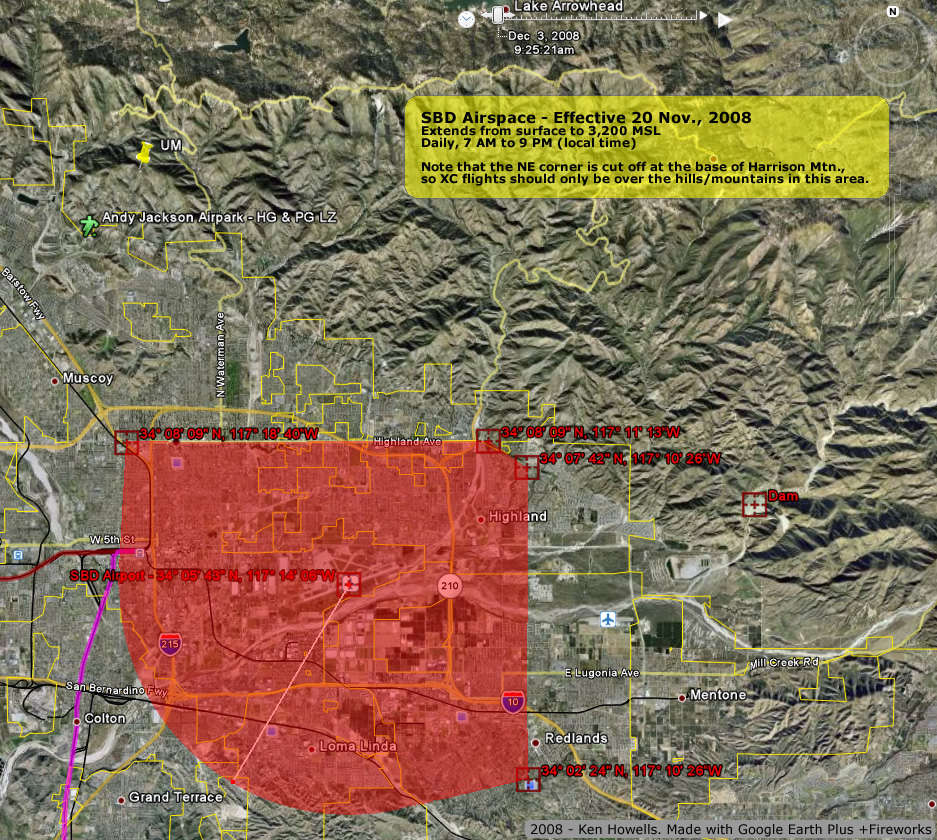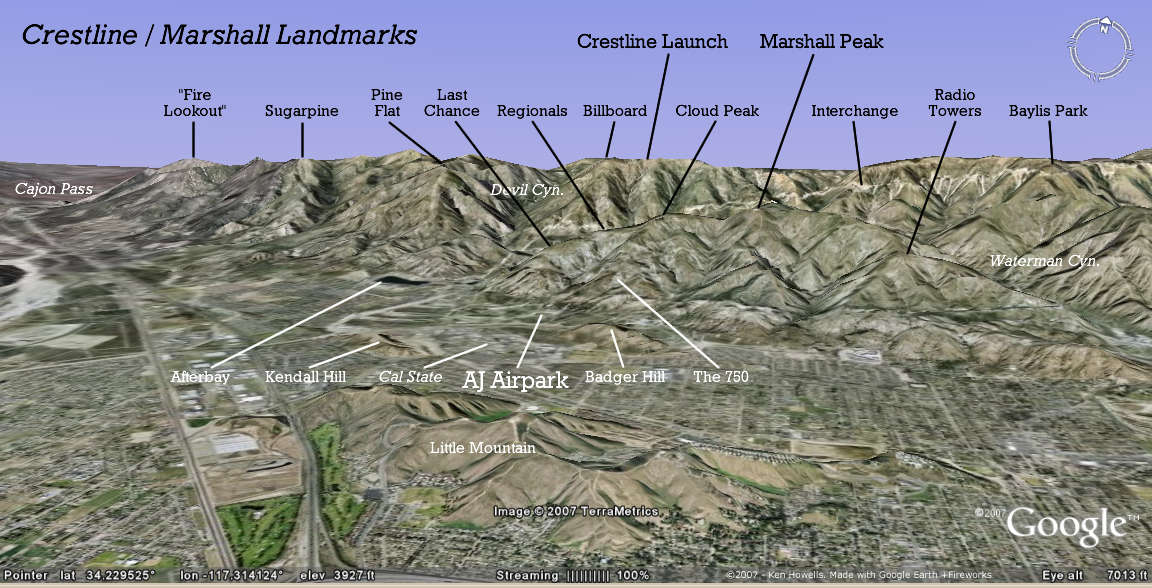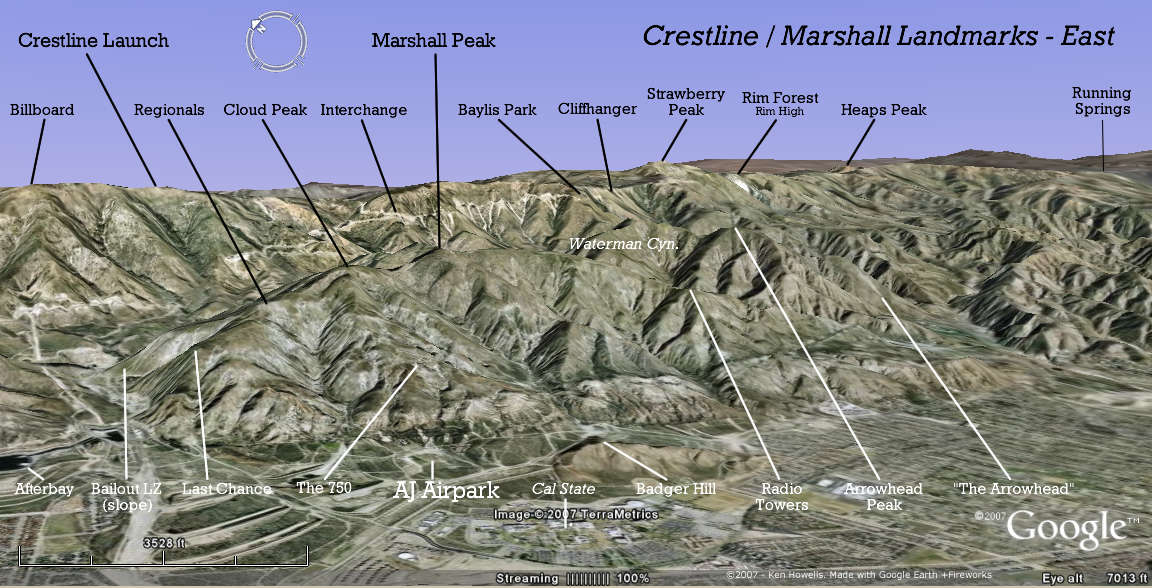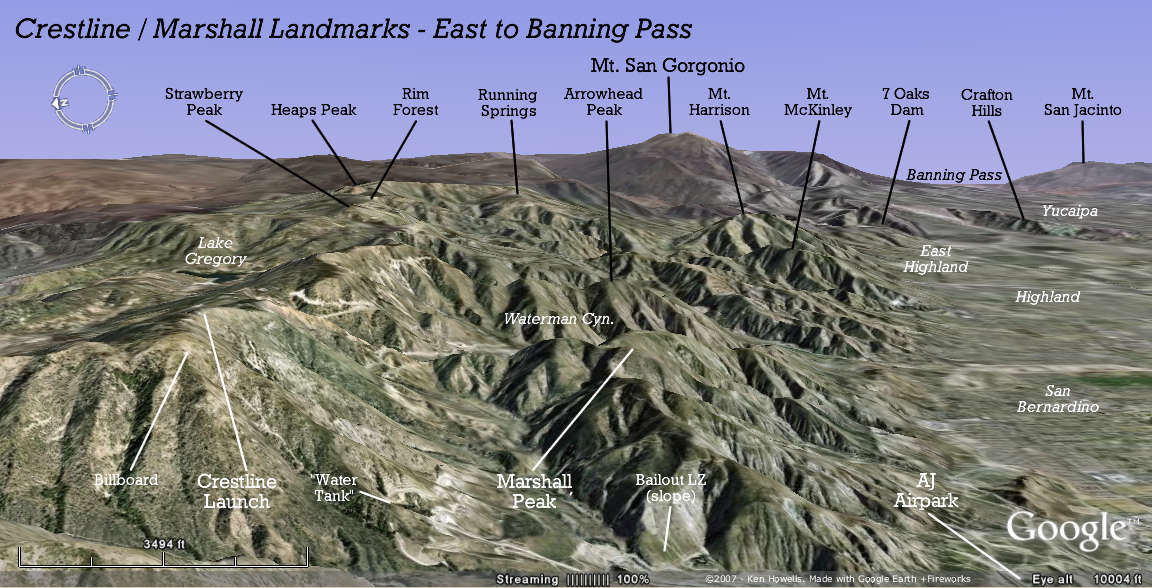Overview
The CSS promotes free flight throughout the San Bernardino Mountains. The CSS sites comprise several launch sites and landing zones, each with its own unique risk factors and mitigation plans that pilots must understand prior to flying. These launch sites and landing zones include:
- Andy Jackson Airpark (AJX)
- Crestline Launch
- Marshall Peak Launch
- Regionals Launch
- 750 Launch
- Training Hill
- Devil’s Canyon Bailout LZ
- Remote Launches in San Bernardino
Pilots must familiarize themselves with these guidelines and site briefings before arriving, and this information DOES NOT replace the need for an in-person site briefing from a local pilot or instructor familiar with the area.
Visiting Pilots: All launches and LZs require a P3/H3 rating or above. Visitors NOT meeting P3/H3 requirements must schedule instruction or observation with a local instructor before arriving.
Details
Membership Requirements
USHPA and CSS memberships (including limited memberships) are required for all pilots and passengers. Persons participating in hang gliding, paragliding, and mini-wing operations at our CSS site are required by law to fly in accordance with FAR Part 103 (or Part 91 if applicable) and should comply with the general safety protocols described by USHPA. This applies to all flight operations including flights from the training hill and kiting in the landing zone.
Memberships can be purchased here.
Pilot Proficiency Requirements
This site requires a USHPA Intermediate (H3 or P3) rating to fly from any launch site above the training hill. Pilots with USHPA memberships but who are below Intermediate level may fly ONLY with local, USHPA certified instructor supervision or sign-off.
Rating requirement details:
| Rating | Restriction |
| Unrated | Fly or kite under direct supervision of an instructor |
| H1/P1 Beginner and H2/P2 Novice without instructor sign-off |
Fly from the HG or PG training hills without supervision
Kite in the LZ without supervision Fly from any launch other then the HG or PG training hill under direct supervision of an instructor |
| H1/P1 Beginner and H2/P2 Novice with instructor sign-off and < 10 hrs airtime | Kite in the LZ without supervision
Fly with yellow streamer Launch only from sites approved on sign-off Fly during first 5 hours and last 2 hours of daylight Follow USHPA operating limits for pilot rating |
| H2/P2 Novice with instructor sign-off and >10 hrs airtime | Follow USHPA operating limits for pilot rating
Launch only from sites approved on sign-off |
| H3/P3 Intermediate and above | Follow USHPA operating limits for pilot rating
Launch from all sites after thorough assessment of conditions and current skill level |
Helmets
Helmets are required for all pilots conducting any flight operations, including kiting in AJX.
Site Weather Conditions
The CSS site is a Western mountain range surrounded by dry desert that often has strong and unforgiving weather conditions. Pilots need to be aware of these conditions and have the skills to launch, fly and land in turbulent air, especially when flying mid-day in the spring, summer and early fall.
The CSS maintains on-line links to weather information and maintains weather stations at the Crestline Launch, Marshall Launch, and AJX. Weather information is available on the CSS website here. Crestline launch weather conditions are also available via the Crestline Windtalker telephone reporting system by calling (909) 338-3362.
In addition, CSS has several accomplished cross country pilots who can help you find and exploit weather forecasts. Further discussion about local conditions can be found in the CSS weather forum here.
Site Shape
We are a bit of a microclimate here based on the shape of the local mountains and our proximity to the Cajon pass. When wind at the surface thru 15K heights come from the W thru N directions we get a wrapping of the winds around the tall terrain to our NW. These are the San Gabriel Mountains. We almost never actually get a true NW wind here. It either wraps around the S side and our winds are SW or it wraps the N side and we get a N wind (often NE). When we get wind that’s strong and directly down the mountain range (from NW or SE) it’s often related to thunder storm gust fronts. I visualize the San Gabriels being like a rock in a stream. The water can’t quite go over the top so it deflects around both sides and there is a convergence on the lee side. Sometimes the convergence is N of the Marshall launch and we get the SW wind and sometimes it’s S of us and we get the N wind.
Front Range Rotor
The prevailing wind at CSS can be from South to the West. This prevailing wind direction can result in rotors off the back of the front range that hosts Marshall and the lower launches. Pilots need to be aware of the possible rotor and avoid flying low and behind the front range.
Air Temp & Humidity
This is another huge factor. The ocean brings a moist cool “marine layer” in and often permeates the entire inland empire splashing like a wave against the ring of our surrounding mountains held in place like the banks of a pond of water. This inversion is usually not taken into account by the FSL and blip maps (Dr. Jack info). Or they know it’s there, but not exactly how far inland it has gone. I have to read between the lines to determine whether what they are saying will actually happen. Example: The FSL says it’s a good lapse rate up to 9K. This would be great except when one looks outside (and looking at the web cam) it shows a very weak but noticeable marine layer up to 3K (halfway up Marshall) at sunrise. What this does is make it not heat up to the trigger temp and we could very likely only get heights to what the marine layer gets up to which could be only 4800′ MSL for example. It’s a bit of an art (sometimes roll of a dice) deciding whether the temps aloft will actually play a part in how high our thermals actually go.
Thermal Block
Another art is deciding whether a thermal block happens. During weak Santa Anas if the lapse rate is good enough, the Marshall area will switch up-slope and have fantastic thermals up to maybe 9K or 10K, even though it blows over the back at Crestline. Climbing and drifting out over the city, yet still cycling up at Marshall.
Rides to Launch
People fly CSS sites seven days a week, weather permitting, so it is usually very easy to get site information and a ride up the hill with your fellow pilots. There are several options, including some instructors looking to fill extra space when driving their students. Details about ride options can be found here. You may also check out our forum dedicated to ride sharing and looking for or offering rides up to our launches here.
Glide to AJX and Other Mountain Features
The primary landing zone at AJX is not visible from the Crestline launch. The landing zone is obscured by the front range that hosts Marshall and the other lower launch. Even if you launch from the lower launches it is normal for pilots to bench up to the back range and fly downrange to areas with no visible line of sight to AJX. Pilots need to always be aware of their location relative to AJX, wind conditions and the glide out to AJX. To help with that awareness, CSS has published glide ratios between prominent features in our flying site. Note that these glide ratios DO NOT ACCOUNT FOR WIND. Pilots need to understand the impact of the wind on their glide when making decisions on how and where to fly.
| Start Glide | End Glide | Start El. (ft) | End El. (ft) |
Change El. (ft) | Distance (ft) | Glide (x:1) |
| Crestline | Regionals | 5250 | 3390 | 1860 | 9700 | 5.2 |
| Crestline | Marshall | 5250 | 4010 | 1240 | 9750 | 7.9 |
| Crestline | Cloud Peak | 5250 | 3840 | 1410 | 9110 | 6.5 |
| Crestline | AJX | 5250 | 1700 | 3550 | 15800 | 4.5 |
| Crestline | Devils Canyon LZ | 5250 | 2000 | 3250 | 9826 | 3.0 |
| Billboard | AJX | 5280 | 1700 | 3580 | 15700 | 4.4 |
| Pine Flats | AJX | 5100 | 1700 | 3400 | 18500 | 5.4 |
| Strawberry Peak | AJX | 6120 | 1700 | 4420 | 30150 | 6.8 |
| Rim of the World HS | AJX | 5790 | 1700 | 4090 | 32250 | 7.9 |
| Keller Peak | AJX | 7882 | 1700 | 6182 | 82850 | 13.4 |
Local Airspace
San Bernardino Airport Class D Airspace
- Extends from surface to 3,200′ MSL
- In effect daily from 7 AM to 9 PM (local time)
- Note that the NE corner is cut off at the base of Harrison Mountain, so XC flights should only be over the hills/mountains in this area.

Commercial Airline Approaches
The CSS site sits under two commercial airline approach patterns to Ontario International Airport. The approach patterns, shown on the site overview diagram, are only 7500′ MSL and pass close to two popular features at our flying site: Billboard and Strawberry Peak. Do not loiter above 6500′ around Billboard or Strawberry Peak. If you are not familiar with these two features and these approach patterns check with a local instructor, CSS board member or an experienced local pilot before flying. Further discussion about these approach patterns can be found here.
Cloudland Truck Trail (2N40)
The Cloudland Truck Trail (2N40) is the road that we use to get to Marshall and the other lower launches. The Cloudland Truck Trail is a narrow dirt road with many blind corners and many areas that are not wide enough for two vehicles to pass. When driving this road, drive slowly and be alert for approaching vehicles.
Aerobatics
Aerobatics are not allowed below 700 ft (AGL) or within 500 ft of any CSS launch.
Hang Gliding Instruction Protocols
AJX is a H3 (Intermediate) site as far as pilots being allowed to launch from all mountain launches above the airpark. Any USHPA pilot member is allowed to launch from the LZ (including the training hill) unsupervised and unrated if they so choose. Instructors may allow and supervise non-rated or Beginner/Novice pilots from any of the launches (including Crestline) if the instructor evaluates student abilities and wind conditions as being appropriate. Please do not abuse this permission.
Progression of New Students
Paperwork, Equipment, and Conditions
All training in the LZ and adjacent training hill requires students to have USHPA memberships and helmets and for the case of pilots without at least novice ratings, wheels are required on the gliders. It is recommended that conditions limit to 12 mph with occasional gusts to 15 mph, although please modify this as wing loading dictates what is appropriate. Caution is advised to avoid times of day where possible gusts caused by dust devils are present. This means that although not specifically disallowed, it is recommended to conduct training hill operations either prior to 11AM or after 5PM during daylight savings time.
Pre-Solo Experience
Before taking new students up for first mountain solos, it is recommended to prepare the student by their having at least 25 flights from the training hill. Mountain solos should only start when the instructor feels it is appropriate. Tandem training is an optional instructional tool and is recommended when feasible. If progressing above the training hill without tandem training, it is best to consider the 750 Launch as then next level. With tandem training, going directly to Marshall from the training hill is usually fine. Use caution if using Crestline for first solos due to the long glide. Though not restricted, it is not recommended.
First Solos
Initial solo flights should have the instructor supervising by direct radio contact. Instructors should be supervising from the LZ for the students’ first couple of flights. Assistant instructors are recommended at launch but not required. As the instructor evaluates student abilities as being able to fly without radio, the student may continue flying additional flights with the instructor conducting non-radio supervision, either from launch or landing or inflight.
Unsupervised Signoff
As the student shows ability to fly in smooth conditions without assistance, the unsupervised signoff form (ask a CSS instructor) may be issued to the student. Note that the USHPA Novice Rating (H2) must be issued prior to issuing this form. Although the student would then be allowed to fly unsupervised, it is recommended to continue supervision whenever feasible. The USHPA mentor program may be a useful option at this point as well.
Paragliding Instruction Protocols
AJX is a P3 (Intermediate) site as far as pilots being allowed to launch from all mountain launches above the airpark. Any USHPA pilot member is allowed to launch from the training hill unsupervised if they so choose. Instructor may allow and supervise non-rated or Beginner/Novice pilots from any of the launches (including Crestline) if the instructor evaluates student abilities and wind conditions as being appropriate. Please do not abuse this permission.
Progression of New Students
Paperwork, Equipment, and Conditions
All training, including ground handling in the LZ, requires students to have USHPA memberships and helmets. It is recommended that conditions limit to 12 mph with occasional gusts to 15 mph although please modify this as wing loading dictates what is appropriate. Caution is advised to avoid times of day where possible gusts caused by dust devils are present. This means that although not specifically disallowed, it is recommended to conduct ground handling either prior to 11AM or after 5PM during daylight savings time.
Pre-Solo Experience
Before taking new students up for first mountain solos, it is recommended to prepare the student by their having at least 15 flights from the training hill. These are recommended minimums – additional flights are fine and mountain solos should only start when the instructor feels it is appropriate. Tandem training is an optional instructional tool and is recommended when feasible.
First Solos
Initial solo flights should have the instructor supervising by direct radio contact. Instructors should be supervising both from launch and from the LZ for at least the student’s first two flights. Instructors may designate an assistant that they feel is qualified for supervision at either launch or landing. Example: Instructor may be at the LZ and the assistant at launch, or visa-versa. As the instructor evaluates student abilities as being able to fly without radio, the student may continue flying additional flights with the instructor supervising (no assistant necessary), either from launch or landing without radio backup.
Unsupervised Signoff
As the student shows ability to fly in smooth conditions without assistance, the unsupervised sign-off form (ask a CSS instructor) may be issued to the student. Note that the USHPA Novice Rating (P2) must be issued prior to issuing this sign-off. Although the student would then be allowed to fly unsupervised, it is recommended to continue supervision whenever feasible. The USHPA mentor program may be a useful option at this point as well.
Rules Enforcement
The CSS Board is to follow this procedure to maintain a fair and predetermined response to rule infractions. If an incident causes a significant and tangible effect on the CSS or to the sport of hang gliding/paragliding, the Board will respond by using the procedures described under Significant Incidents. Incidents need not be witnessed by a Director or a CSS member to result in action by the Board.
Standard Incidents
Standard Incidents include infractions of all Site Protocols. The following procedures will be followed in case of violations of Standard Incidents.
First Infraction
Verbal Warning from a Director. The Verbal Warning to the pilot shall include:
- A description of the rule and the Incident.
- A warning that the next Incident will result in a Written Warning.
Most Incidents are errors of ignorance or other unintentional acts. In any case, the pilot should be given the benefit of any doubt, and the Verbal Warning must be respectful and non-confrontational. The Verbal Warning will be discussed at the next Board meeting and recorded in the Board Minutes.
Second Infraction
A Written Warning may result if a pilot repeats an Incident within 18 months after receiving an Verbal Warning. The Board shall, at a regular or special meeting, discuss the Incident. The alleged violator shall be requested to participate. After the discussion, the Board shall vote to issue a Warning from the Board to the pilot.
The Written Warning, if issued, shall include:
- A description of the rule and the infraction.
- A description of the prior Warning.
- A warning that the next Infraction will result in a Suspension of Flight Privileges of up to two months.
Third Infraction
May result in a Flying Privilege Suspension.
A Flying Privilege Suspension may result if a pilot repeats an Incident within 18 months after receiving a Written Warning. The suspension may be up to two months in length. The Board shall, at a regular or special meeting, discuss the Incident. The alleged violator shall be requested to participate. After the discussion, the Board shall vote to suspend the pilot’s flying privileges and issue a written notice providing details of the suspension, if appropriate.
The notice shall include:
- A description for the rule and the infraction.
- A description of the prior warnings.
- The period of the flying suspension, this may be up to two months in length for this category of incident.
- A warning that the next infraction will be treated as a Significant Incident and may result in a lengthy Flying Privilege Suspension.
Significant Incidents
Significant Incidents include any infraction that causes a significant or tangible negative effect on the CSS or the sport of hang gliding/paragliding. A continued pattern of Standard Incidents may also be treated as a Significant Incident (see above). For this reason, the enforcement policy is rigid and serious. A lengthy, up to and including permanent, Suspension of Flight Privileges may result from this category of Incident. The Board shall, at a regular or special meeting, discuss the Incident. The alleged violator shall be requested to participate. After the discussion, the Board shall vote to determine the appropriate sanction, if any. A written notice providing details of any sanction will be provided to the violator.
The notice shall include:
- A description for the rule and the infraction.
- A description of the prior warnings (where appropriate).
- The period of the flying suspension, this may be up to a permanent Flying Privilege Suspension for this category of incident.
A Flying Privilege Suspension of one year or more is to be considered an extreme remedy. A suspension of this type may be appealed at the subsequent Annual Meeting (either Spring or Fall, whichever occurs first). The CSS Board may take subsequent action to commute a permanent Flying Privilege Suspension to a suspension with a fixed term.
Last Revised: March 5, 2021
Additional Info
- Site Frequency: 145.555
- Other Frequencies: Read more here
- Emergencies: Follow the instructions and information available in the CSS Emergency Action Plan.
- Rides: Need a ride to launch?



